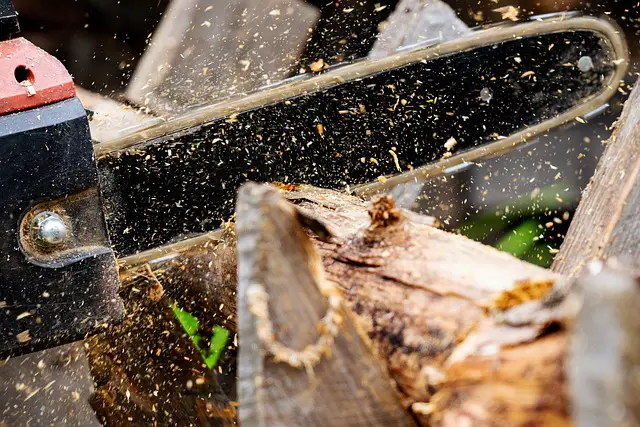Chainsaws come with a blade or guide bar that rotates at high speed to make precise cuts through the wood. But have you ever wondered if you can put a smaller blade on a chainsaw?

The answer to this question is not straightforward and depends on many factors.
A chainsaw can usually run three different bar lengths. The guide bar is measured from one end to the other and can be between 14 and 40 inches. Your chainsaw operator’s manual will often indicate what size bars you can use with your chainsaw model.
Here, we will explore the pros and cons of using a smaller blade on a chainsaw, what to consider before making the change, and how it can impact your cutting experience.
What are the Benefits of a Smaller Blade on a Chainsaw?
One of the primary benefits of a smaller blade on a chainsaw is improved maneuverability. Smaller guide bars are lighter, shorter, and less intimidating for beginners than longer blades.
They are perfect for cutting through trees with a smaller diameter, limbs, and branches, making them a great choice for pruning and trimming jobs.
Another advantage of a smaller blade is that it reduces kickback, which can make it easier to maintain control of the saw. Therefore, if you are looking for a more precise cut in tight spots, a smaller blade might be the best choice.
What are the Drawbacks of a Smaller Blade on a Chainsaw?
A smaller blade has its limitations that can be problematic for many applications.
First, it reduces your cutting capacity, making it more challenging to cut through thicker logs and trees. You may have to make multiple passes, which can be time-consuming and tiring.
Second, a smaller blade can reduce the lifespan of your chainsaw’s engine by putting extra stress on it. This damage can come in the form of overheating or wear and tear on your chainsaw’s internal components.
Therefore, if you plan on cutting larger logs and trees regularly, you might want to stick with a larger blade.
What to Consider Before Changing Your Chainsaw Blade Size?
Before deciding on what blade to use, you need to consider the type of work you intend to do, the power of your chainsaw, and the brand’s recommendations.
Smaller chainsaws are specifically designed for cutting small trees and branches, and smaller blades work well for this.
Larger chainsaws are powerful enough to cut through thicker logs and trees, and larger blades work best for this. However, you might want to consider the following factors before deciding:
- The length and thickness of the logs you will be cutting
- The type and quality of the guide bar and chain you are using
- Whether your chainsaw has enough power to handle the smaller blade
- The kind of wood you plan on cutting
- How often you intend to use your chainsaw
How Can a Smaller Blade Impact Your Cutting Experience?
After swapping out the blade to a smaller size, you will notice a difference in how it cuts. You will have more control and finesse with a smaller blade, making it easier to make precise cuts.
The saw will also be easier to handle since it will be less cumbersome, and you will be able to hold it for longer periods without getting tired. However, you will need to take more time with larger logs and trees since you might have to make multiple passes to get through them.
With a smaller blade, the chainsaw will operate at a higher RPM level, which means you need to keep it well-oiled and maintained to avoid overheating.
Final Thoughts
In conclusion, whether you can put a smaller blade on a chainsaw depends on many factors.
Smaller blades offer improved maneuverability and precision, reduced kickback, and are perfect for cutting smaller diameter trees. However, they have their limitations, such as reduced cutting capacity, and can put extra stress on your chainsaw’s engine.
Before changing your chainsaw’s blade, make sure to consider the type of work you plan on doing, the power of your chainsaw, and the brand’s recommendations.
With these factors in mind, you can make an informed decision that ensures your chainsaw operates optimally for the job at hand.

